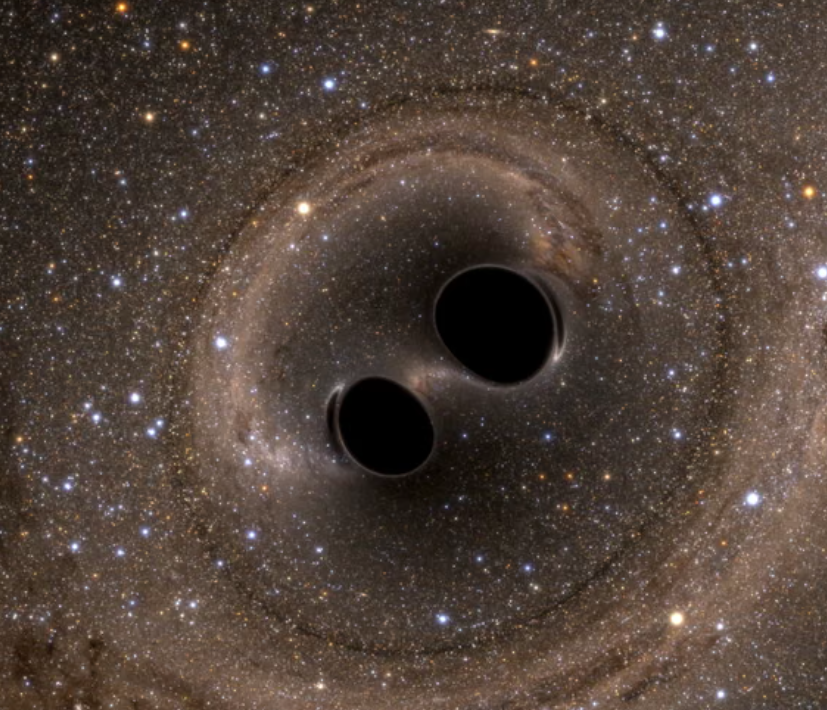Science
Gravitational Waves Reveal New Insights from Black Hole Mergers

Recent advancements in gravitational wave astronomy have led to significant discoveries regarding black holes. In October and November 2024, the LIGO-Virgo-KAGRA collaboration detected two black hole mergers that challenge existing theories about their formation and evolution. Both events exhibit unique characteristics, including rapidly spinning black holes in unequal mass pairs, indicating a violent history rather than a calm stellar origin.
Details of the Mergers
The first of these remarkable events, designated GW241011, occurred approximately 700 million light years away. This merger involved two black holes with masses of 20 and 6 solar masses. Notably, the larger black hole was one of the fastest rotating examples documented through gravitational waves, showcasing extraordinary properties that have not been seen in prior observations.
Just one month later, the team detected a second merger, GW241110, at a distance of 2.4 billion light years. This event featured black holes weighing 17 and 8 solar masses, and presented an unprecedented scenario where the primary black hole spun in the opposite direction to its orbit. This configuration has never been directly observed before, further complicating our understanding of black hole behavior.
Implications for Black Hole Formation
The spin characteristics of both mergers raise important questions about the origins of these black holes. Traditionally, black holes formed from the collapse of massive stars tend to have moderate spins aligned with their original motion. However, the extreme spins observed in both GW241011 and GW241110 suggest these may not be first-generation black holes. Instead, they likely represent second-generation black holes resulting from prior mergers that imparted rapid spins and unpredictable directions.
In each case, the larger black hole was nearly double the mass of its counterpart, a pattern more consistent with hierarchical mergers rather than binary stars formed together. This observation supports the theory that these black holes originated in dense stellar environments, such as globular clusters, where frequent interactions and mergers are common. These repeated collisions can significantly alter mass and spin, leading to the unusual properties now being documented.
The clarity of the gravitational wave signal from GW241011 allowed astronomers to test Albert Einstein’s theory of general relativity with remarkable accuracy. The rapid rotation of the primary black hole causes a slight deformation, an effect predicted by mathematician Roy Kerr’s solution for rotating black holes. This deformation creates a distinctive signature in the gravitational waves that aligns closely with theoretical predictions.
The data from this merger also revealed higher harmonics, akin to overtones produced by musical instruments, further confirming aspects of Einstein’s theory. As detector sensitivity improves, the potential for more discoveries like GW241011 and GW241110 increases. These findings could uncover even more diverse environments where black holes collide and enhance our understanding of the fundamental laws governing these extreme objects in our universe.
These recent discoveries mark an exciting chapter in the field of gravitational wave astronomy, promising to reshape our understanding of black hole formation and the intricate dynamics of the cosmos.
-

 World4 weeks ago
World4 weeks agoGlobal Air Forces Ranked by Annual Defense Budgets in 2025
-

 Top Stories4 weeks ago
Top Stories4 weeks agoNew ‘Star Trek: Voyager’ Game Demo Released, Players Test Limits
-

 World4 weeks ago
World4 weeks agoMass Production of F-35 Fighter Jet Drives Down Costs
-

 Science4 weeks ago
Science4 weeks agoTime Crystals Revolutionize Quantum Computing Potential
-

 World4 weeks ago
World4 weeks agoElectrification Challenges Demand Advanced Multiphysics Modeling
-

 Business4 weeks ago
Business4 weeks agoGold Investment Surge: Top Mutual Funds and ETF Alternatives
-

 Top Stories4 weeks ago
Top Stories4 weeks agoDirecTV to Launch AI-Driven Ads with User Likenesses in 2026
-

 Lifestyle4 weeks ago
Lifestyle4 weeks agoDiscover Reese Witherspoon’s Chic Dining Room Style for Under $25
-

 Entertainment4 weeks ago
Entertainment4 weeks agoFreeport Art Gallery Transforms Waste into Creative Masterpieces
-

 Health4 weeks ago
Health4 weeks agoGavin Newsom Critiques Trump’s Health and National Guard Plans
-

 Business4 weeks ago
Business4 weeks agoUS Government Denies Coal Lease Bid, Impacting Industry Revival Efforts
-

 Science4 weeks ago
Science4 weeks agoRemembering David E. Brest: A Life Dedicated to Nature and Family








